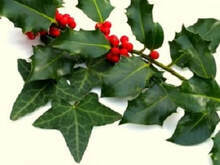David Tickner's Blog, page 9
December 15, 2023
Holly & Ivy
 Holly
HollyThe word holly, from the mid-15th century, has its origins in Proto-Indo-European (PIE) kel (to prick), Proto-Germanic hulin, Old English holegn and holen, and 12th century holin. Holly is an evergreen tree long used as part of Christmas and pre-Christmas decorations.
Ivy
Ivy comes from Old English ifig. Before this, the origins of the word ivy are unknown. In the mid-15th century, the image of an ivy bush was used on the signage of taverns which served wine, ivy being sacred to Bacchus, the Roman god of wine and other things.
Holy & Ivy
In ancient times, holly was thought to be a male plant and ivy a female plant.
The ancient Romans used holly in different ways—to ornament the home as an omen of good fortune and immortality. Holly wreaths were sent to newlyweds for the same reason. And holly was used during the December Saturnalia festival. Early Christians, celebrating Christmas at this time, used holly as the spiky leaves symbolized Jesus’s crown of thrones and the red berries symbolized his blood. Harry Potter’s wand is made of holly, by the way.
Ivy, in addition to being associated with wine and intoxication as in the mythology of Bacchus and Dionysus, was also a symbol of fidelity and marriage. Ivy was wound into a crown, wreath, or garland as a symbol of prosperity and charity. As such, ivy was adopted by the early Christian church as a reminder to help the less fortunate.
The Christmas carol ‘The holly and the ivy’ is based upon such ancient beliefs which were absorbed by the Christian church. The carol sung today was first recorded by Cecil Sharp, a folk song collector, who heard it sung in England in 1909.
Scroll down the following link for a couple of versions of the song: https://mainlynorfolk.info/steeleye.span/songs/thehollyandtheivy.html
I like the pub version!
Reference: Online Etymological Dictionary, https://www.etymonline.com/
https://davesgarden.com/guides/articles/view/2731
Published on December 15, 2023 07:59
December 12, 2023
Egg Nog
 The origins of egg nog are unknown. It is likely related to medieval English posset—a hot, milky, ale-like drink. In the 13th century, monks drank posset with eggs and figs.
The origins of egg nog are unknown. It is likely related to medieval English posset—a hot, milky, ale-like drink. In the 13th century, monks drank posset with eggs and figs.Does the word nog refer to a cup or to the contents of the cup? Some sources suggest that nog has its origins in the medieval term noggin, a small wooden mug used to serve alcohol. However, in the 17th century, the word nog also referred to a strong English beer.
By the 1670s, a boull (bowl) of nog was something shared with friends and guests.
In brief, egg nog refers to a sweet, rich, and stimulating cold drink made of eggs, milk, sugar, and spirits. Old recipes suggested using beer or wine instead of milk. Egg nog is the British term.
Eggnog, from 1775, is the American term. If you are thinking of making your own eggnog, here is a recipe from that time:
One quart cream, one quart milk, one dozen tablespoons sugar, one pint brandy, 1/2 pint rye whiskey, 1/2 pint Jamaica rum, 1/4 pint sherry—mix liquor first, then separate yolks and whites of a dozen eggs, add sugar to beaten yolks, mix well. Add some milk and cream, slowly beating. Beat whites of eggs until stiff and fold slowly into mixture. Let set in cool place for several days. Taste frequently.
Enjoy!
Reference: Online Etymological Dictionary, https://www.etymonline.com/
https://time.com/3957265/history-of-eggnog/
https://en.wikipedia.org/wiki/Eggnog
David’s Wordshop Blog: http://www.davidtickner.ca/blog
www.davidtickner.ca
Published on December 12, 2023 14:13
December 8, 2023
Toast
 How do you prefer your toast? Hot or cold? Toasted? Grilled? Do you like a piece of spiced toast in your glass of wine or ale?
How do you prefer your toast? Hot or cold? Toasted? Grilled? Do you like a piece of spiced toast in your glass of wine or ale?The verb ‘to toast’ has its origins in the Proto-Indo-European (PIE) root ters (to dry), Latin tostare, and 12th century Old French toster (to toast, to grill, roast, burn). The verb ‘to toast’ (to brown with heat) appears in English in the late 14th century. From ters to toast—not much has changed over the years.
The noun toast, meaning a piece of bread browned by fire or dry heat, is from the early 15th century. Originally, toast was something added to wine or ale—sort of like croutons in soup or salad. The custom of putting such a bit of plain or spiced toast in a mug of ale at a tavern is well-known from the drinking songs of the 17th century.
The noun toast, meaning a call to drink to someone’s health, is from the 1690s. The verb ‘to toast’, meaning to propose or drink a toast, is from 1700. From 1704, a person who proposed a drinking toast was called a toaster. The use of toast to refer to the person whose health is proposed and drunk to is from 1746. The term toastmaster is from 1749. In contrast, the slang phrase, “He’s toast”, from 1987, means a person or thing already doomed or destroyed.
Originally, such toasts were directed to a beautiful or popular woman whose health is proposed and drunk to. Here’s an anecdote from The Tatler, an early 18th century British literary and society journal: “Steele's story ["Tatler," No. 24] is that an (unnamed) beauty of the day was taking the cold waters at Bath, when a gentleman dipped his cup in the water and drank it to her health; another in his company wittily (or drunkenly) replied that, while he did not care for the drink, he would gladly enjoy the toast” (Online Etymological Dictionary).
But back to the kitchen. The use of electrical toasters is from 1913. The term ‘toaster-oven’ appears in 1957.
So, how do you prefer your toast? Hot or cold? Toasted, grilled? Check out this amusing article:
https://www.theguardian.com/lifeandstyle/2014/dec/09/how-to-eat-toast
Reference: Online Etymological Dictionary, https://www.etymonline.com/
Published on December 08, 2023 19:40
December 5, 2023
Gaslighting
 Gaslighting
GaslightingThe term gaslighting is from Gaslight, a 1944 psychological thriller set in the 19th century about a married woman who has inherited a valuable estate. In the house in which she and her husband are living, the woman is plagued by irritating noises from the boarded-up attic. She also notices that the gaslights in the house often dim and then become bright again for no apparent reason.
Her husband assures her that this is only her imagination. However, he is slowly manipulating her into believing that she is descending into insanity. He wants to have her institutionalized in order to take control of her estate. He is one who is creating these noises and flickering lights.
The film received seven Academy Awards nominations, including one for Best Picture.
The first known use of the term gaslighting for such psychological manipulation was in 1961.
Gaslighting was the Merriam-Webster Dictionary’s Word of the Year for 2022.
Gas
The word gas has its origins in Greek khaos (empty space; chaos, the confused unorganized state of primordial matter before the creation of forms). The word gas, first used by the Flemish chemist J.B. van Helmont (1577 – 1644), appears in English in the 1650s. The modern scientific use of the word gas as one of the four basic states of matter began in 1779; e.g., natural gas (primarily methane), laughing gas (nitrous oxide), carbon monoxide, hydrogen, and others.
Light(ing)
The word light has its origins in Proto-Indo-European (PIE) leuk (light, brightness) and Old English leht (brightness, radiant energy, that which makes things visible). The word lighting appears in English before the 12th century.
Gas lighting
As early as 1801, gas was being used to illuminate lamps in houses and gardens. In 1806, some streets in Salford, Lancashire, UK are thought to be where gas was first used for street lighting anywhere in the world.
-o-
Speaking of Greek khaos (chaos), the opposite term is kosmos (order; the ordered cosmos). Cosmos is the origin of the word cosmetic—a product which brings order to the chaos of a face! But that’s another story.
Reference: Online Etymological Dictionary, https://www.etymonline.com/
Published on December 05, 2023 20:42
Fork
 I remember being a pre-school child laying in bed one night wondering how things got their names.
I remember being a pre-school child laying in bed one night wondering how things got their names.As I lay in bed, I thought of the corner store beside our house. At the back of store was a mysterious room that always seemed dark when I walked past the open door. As I lay in bed, I imagined a group of adults sitting in a circle in this room picking up different objects and trying to decide what to call them. At one point, a person held up an object and everyone suggested different sounds until finally someone said, “Fork.” There were grunts and nods of approval. And so, that’s how the fork got its name, or so I thought at the time. A dream? A memory?
The Online Etymological Dictionary tells us that the word fork comes from Old English forca (forked instrument) and Latin furca (two-pronged fork). Aside from this, the origins of the word fork are uncertain. A colleague mentioned that the word furca is also found in the language of the Dacian territory of Romania. And so, quite likely that the Romans in ancient Romania would likely have brought this word to Latin.
Table forks appear in the mid-15th century but were not in common use until the 17th century.
Yet another example of an ordinary everyday word of heart and home which has come to us almost unchanged over the centuries.
Reference: Online Etymological Dictionary, https://www.etymonline.com/
https://www.foodandwine.com/lifestyle/the-fork-explained
Published on December 05, 2023 20:39
November 23, 2023
Acme or Apex?
 When I was a child, I lived next door to a neighbourhood corner store called Apex Grocery. When I asked what apex meant, my father told me that it meant the top of a hill. And, in fact, our house and the store were at the top of a hill. Curiosity satisfied. For the moment.
When I was a child, I lived next door to a neighbourhood corner store called Apex Grocery. When I asked what apex meant, my father told me that it meant the top of a hill. And, in fact, our house and the store were at the top of a hill. Curiosity satisfied. For the moment. Over the years, I kept hearing the words apex and acme used almost interchangeably to mean the top of something. I wondered why we would need two words to mean the same thing. Do they mean the same thing?
The word acme appears in English in the 1560s from Greek akme (the highest point, the peak of anything) and Proto-Indo-European (PIE) ak-ma (to be sharp, to rise to a point).
The word apex appears in English around 1600 from Latin apex (summit, peak, tip, top, extreme end) and PIE ap-(1) (to take, to reach).
Given their similarities, how are they different? In brief, apex usually means the actual top of something; e.g., the apex of hill or mountain or trajectory, the top of a pyramid. In nature, an apex predator is an animal at the ‘top’ of the food chain.
On the other hand, acme tends to be used more subjectively; e.g., this hotel suite is the acme (the height) of luxury and comfort or she is the acme (an exemplar) of good taste.
Curiosity satisfied. Again.
Reference: Online Etymological Dictionary, https://www.etymonline.com/
Published on November 23, 2023 17:13
November 16, 2023
Blue
 Click hBlue moon. Blue in the face. The blues. True blue. Blue stocking. Blue movies. Blue ribbon. Cursing a blue streak. Blue grass. Blueprints. Blue murder. Blue balls. Blue plate special. A bolt from the blue. Blue suede shoes (remember this one?!). Out of the blue. Bluebeard. Feeling blue. Blue chip. Blue pencil. Blueberries. Bluetooth. Blue collar. Bluesky Social. Blue jeans. Blue blood. Bluenose (a nickname for Nova Scotians since the 17th century). Have you been at a meeting lately in which someone suggested, “Let’s do some blue sky thinking...”?
Click hBlue moon. Blue in the face. The blues. True blue. Blue stocking. Blue movies. Blue ribbon. Cursing a blue streak. Blue grass. Blueprints. Blue murder. Blue balls. Blue plate special. A bolt from the blue. Blue suede shoes (remember this one?!). Out of the blue. Bluebeard. Feeling blue. Blue chip. Blue pencil. Blueberries. Bluetooth. Blue collar. Bluesky Social. Blue jeans. Blue blood. Bluenose (a nickname for Nova Scotians since the 17th century). Have you been at a meeting lately in which someone suggested, “Let’s do some blue sky thinking...”?Can you think of words that are as versatile and as widely used in idioms and colloquial language as the word blue? Blue is the basis for dozens of common idioms and phrases covering a wide range of meanings and uses.
Ever wondered why blue is associated with boy babies and pink with girl babies? This color coding became predominant in the 20th century. Before that pink (or red) was the boy color and blue was the girl color; that is, if there was any differentiation at all. There is considerable debate about how and when this color-coding shifted.
Where does the word blue come from? The word blue has always been (more or less) blue. The word has not changed much in hundreds (or thousands) of years. Blue comes from Proto-Indo-European (PIE) bhle (blue, light-colored), PIE bhel (to shine), and, later, Proto-Germanic bloewaz, the source of Old Saxon and Old High German blao, Danish blaa, Swedish bla, Old Frisian blau, Middle Dutch bla, Dutch blauw, German blau, and Old English blaw—all meaning blue. Around 1300 the word bleu, meaning the color of the clear sky, arrives in English from Old French bleu.
The present spelling, blue, is from the 1500s.
Reference: Online Etymological Dictionary, https://www.etymonline.com/
Verde, T. (March – April 2021). The quest for blue. Aramcoworld, 72(2), 6 – 15. https://www.aramcoworld.com/Articles/February-2021/The-Quest-for-Blue
ere to edit.
Published on November 16, 2023 21:02
November 13, 2023
Denim, Jeans, Dungarees
 How are denims, jeans, and dungarees related? All three words have their origins in the names of places.
How are denims, jeans, and dungarees related? All three words have their origins in the names of places.When I was a kid, hardly anyone wore jeans to school. We wore pants. The kids who wore jeans tended to have a reputation for getting into trouble. I didn’t get my first pair of jeans or ‘work pants’ until after high school when I got a summer job in forestry to help pay my way through university. I remember that those jeans cost $5.00.
Denim
The word denim, from the 1690s, is from French serge de Nimes (serge from Nimes), serge being a type of cloth from the town of Nimes in southern France. The name Nimes is from Latin Nemausus and Gaulish nemo (sanctuary).
The use of denim in American English to mean coarse, twilled cotton cloth is from 1850. The word denims meaning pants or overalls made from denim is from 1868.
Jean, Jeans
The word jean, from the mid-15th century, refers to a type of twilled cotton cloth known as fustian. The French term jean fustian meant fustian from the Italian city Genoa; i.e., jean was a type of cloth from Genoa. In the 19th century, jean was a fabric used to make men’s work clothing. The plural form, jeans, is from the mid-19th century. The word jeans, meaning trousers made from jean, is from 1908. In brief, jeans were made from jean.
Jeans were not originally blue. Originally the cloth was dyed from the bark or young shoots of walnuts to create a color known as ‘butternut’ which is similar to the color often seen in the Carhartt brand of work clothing.
Dungarees
The English word dungaree first appears in the 17th century from Hindi dungri, a cheap, coarse thick blue or white cotton cloth worn by workers in the dockside village of Dongri, part of the city of Mumbai. Dungri cloth was exported to England and used for the manufacture of cheap, robust work clothes; i.e., dungarees.
Blue jeans
Originally, any garments (trousers, overalls, coats) made from blue-dyed denim, jean, or dungri cloth were called blue jeans.
However, in the late 19th century the term ‘blue jeans’ referred only to a particular style of trousers with copper-riveted pockets invented by Jacob W. Davis in 1871 and patented by Davis and Levi Strauss in 1873. These trousers or blue jeans were originally intended for men working in the mining industry.
In the early 20th century, many workers wore blue jeans or other durable blue outfits as ‘coveralls’ or ‘overalls’ to protect their regular clothes from dirt and grease. The term ‘blue collar worker’, from 1924, has its origins in reference to these blue garments.
In the 1950s, blue jeans came to symbolize rebellion against social norms; for example, as seen being worn in movies such as The Wild One and Rebel Without a Cause. To this day, blue jeans or jeans are designed and worn to make some kind of social or fashion statement. They are no longer just work clothes.
Why do blue jeans fade?
“Originally, the blue color of jeans came from a natural indigo dye. The dye was chosen for the way it interacted with cotton. When heated, most dyes penetrate the cotton fibers but indigo dye attach only to the fiber's surface. The result? During each wash, some of the fibers and dye molecules escape, giving jeans that signature faded look over time.
Today, jeans are dyed with a synthetic indigo dye. Take a closer look and you'll see a clever design. The warp thread is dyed but the weft thread is left white. This reduces the amount of dye needed for each pair of jeans. It's also why many jeans are blue on the outside but white on the inside” (Business Insider, December 2017).
Reference: Online Etymological Dictionary, https://www.etymonline.com/
https://en.wikipedia.org/wiki/Jeans
https://www.businessinsider.com/why-jeans-are-blue-2017-12
https://en.wikipedia.org/wiki/Blue-collar_worker#References
Published on November 13, 2023 08:12
November 10, 2023
Memory, Remembrance
 Memory
MemoryDo you remember memory work from elementary school? Did you ever have to memorize a poem or a passage of literature? Did you ever have to learn anything ‘by heart’?
The word memory has its origins in the PIE root (s)mer-1 (to remember), Greek mermera (to care) and merimna (care), and Latin memoria and memor (mindful). PIE (s)mer-1 is also the source of Sanskrit smarati (he remembers) and the source of the name Mimir, the giant who guards the Well of Wisdom in Norse mythology.
The word memory (meaning the recollection of someone or something; remembrance, awareness of consciousness of someone or something) comes to English in the 13th century via Old English mimorian, Middle English memorie, and 11th century Old French memorie (mind, memory, remembrance; memorial, record). The word almost remembers itself over the years!
The word memory as the faculty or mental capacity of remembering or retaining unconscious traces of conscious impressions or states, and of recalling these to consciousness in relation to the past, is from the late 14th century.
The verb ‘to memorize’ (to commit to writing, to cause to be remembered by writing or inscription) is from the 1590s. Memorize meaning to commit to memory, to learn by heart, to always have in mind, is from 1838.
Memory as anything that is fixed in or recalled to the mind is from 1817; however, this sense that memory is ‘fixed’ is called into question by current cognitive science. A neurosurgeon cannot ‘find’ a memory in the brain. Rather, each memory is re-created or constructed as we ‘re-member’.
Remember, Remembrance
The word remember is from Latin re (back, again) + memorari (to be mindful of) = rememorari (to recall to mind, to remember), from memor (mindful) and from the PIE root (s)mer (to remember).
Remembering implies mindfulness and paying attention. We easily remember memories linked to affect and emotion. Remember is a word that combines mindfulness and heartfeltness. In contrast to recall which suggests an effort to bring something back into memory, we easily remember because for some reason we care. We care to remember.
One year when I was in elementary school, my class memorized John McRae’s poem In Flanders Fields. Years later I cannot watch a Remembrance Day ceremony or see a poppy on a sombre veteran’s proud chest without echoes of the poem in my mind and heart. I remember my grandfather and the story of his being wounded at Vimy Ridge on 9 April 1917.
Reference: Online Etymological Dictionary, https://www.etymonline.com/
David’s Wordshop Blog: http://www.davidtickner.ca/blog
Tisdale, S. (2023, November). Mere belief: Sliding down the curve of forgetting. Harper’s Magazine, 347 (2082), 54 – 61.
www.davidtickner.ca
Published on November 10, 2023 08:07
Posse
 Have you heard the term ‘posse’ used to refer to a gang or group of people that hang around with someone famous?
Have you heard the term ‘posse’ used to refer to a gang or group of people that hang around with someone famous?The origins of the word posse are related to Latin potis (powerful, able, capable, possible) and potere (to be powerful); words which are the source of the word potent.
The English word posse is from Latin posse (to have power, to be able). The Latin term posse comitatus refers to a body of men who represent the force of a county; i.e., posse + comitatus (of the county). In English law, a local sheriff is empowered to call a posse comitatus into service for support in the execution of the law, in cases of rescue or riot, or in other similar circumstances to preserve the public peace.
The word posse, a shortening of posse comitatus, came to English in the 1640s with the general sense of an irregular or temporary armed force.
Posse, meaning a small gang, is “probably from Western movies popularized by Hollywood in the mid-20th century” (Online Etymological Dictionary).
Merriam-Webster states, “Preserving the public peace so often meant hunting down a supposed criminal that posse eventually came to mean any group organized to make a search or embark on a mission.” In addition, Merriam-Webster states, “In even broader use, posse can refer to any group. [For example…] Sometimes nowadays such a group is a gang or a rock band but it can as easily be any group—politicians, models, architects, tourists, children, or what have you—acting in concert” (Merriam-Webster).
Image: https://www.dailymail.co.uk/tvshowbiz/article-3212447/Ruby-Rose-joins-Taylor-Swift-s-celebrity-posse-pair-hang-Los-Angeles-not-long-Ruby-revealed-interview-wanted-best-friend.html
Reference: Online Etymological Dictionary, https://www.etymonline.com/
David’s Wordshop Blog: http://www.davidtickner.ca/blog
www.davidtickner.ca
Published on November 10, 2023 08:05



